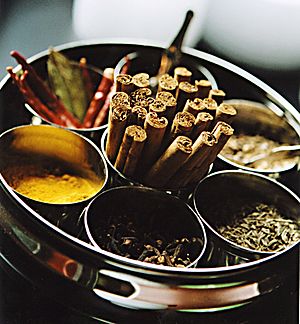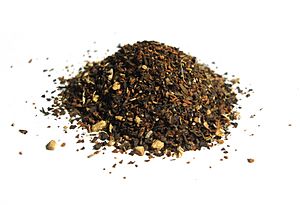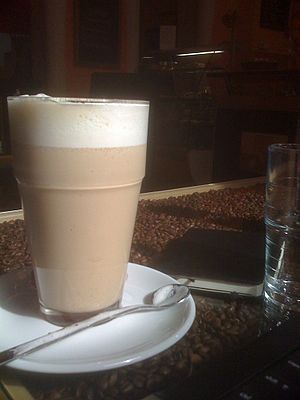Masala chai facts for kids
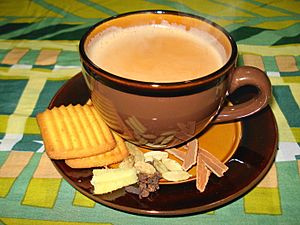
Masala chai served with biscuits
|
|
| Alternative names | Spiced tea |
|---|---|
| Type | Flavoured tea |
| Place of origin | India |
| Main ingredients | Black tea, Milk, Spices, Sugar |
Masala chai (/tʃaɪ/, lit. mixed-spice tea; Hindi: मसाला चाय) is an Indian tea beverage made by boiling black tea in milk and water with a mixture of aromatic herbs and spices. Originating in India the beverage has gained worldwide popularity, becoming a feature in many coffee and tea houses.
The term chai originated from the Hindi word chai, which was derived from the Chinese word for tea, cha . In English, this spiced tea is commonly referred to as masala chai, or simply chai, even though the term refers to tea in general in the original language. According to stories, it originates from thousands of years ago in now modern India and said that the king created masala chai as an Ayurvedic beverage - a blend of herbs and spices to drink for healing purposes. Chai has become a popularized item in western culture, with numerous coffee houses using the term chai latte or chai tea latte for their version to indicate that it is made with steamed milk, much like that used to make a caffè latte, but mixed with a spiced tea concentrate instead of espresso. By 1994, the term had gained currency on the U.S. coffeehouse scene.
Contents
Ingredients
Tea
Black tea is typically used as base in most chai recipes. The most common type of black tea is Assam; however, a blend of different tea variations may be used. Assam, Darjeeling, and Nilgiri are the three most common types of tea used in chai in India.
Spices
The traditional masala chai is a spiced beverage brewed with different proportions of warming spices. The spice mixture, called karha, uses a base of ground ginger and green cardamom pods. Other spices are usually added to this karha including one or more of cinnamon, star anise, fennel seeds, peppercorn, nutmeg, cloves, cardamom seeds, ginger root, honey, vanilla, and other spices. In the Western world, using allspice, to either replace or complement the cinnamon and clove, is also common.
Traditionally, cardamom and ginger are the dominant notes, supplemented by other spices such as cloves, or black pepper; the latter two add a heat to the flavour and the utilization of cloves is more typical and popular throughout India. The traditional composition of spices often differs by climate and region in Southern and Southwestern Asia.
For example, in Western India, cloves and black pepper are expressly avoided, and lemongrass is also often included. The Kashmiri version of chai is brewed with green tea instead of black tea and has a more subtle blend of flavourings: almonds, cardamom, cinnamon, cloves, and sometimes saffron. In Bhopal, typically, a pinch of salt is added.
Other possible ingredients include nutmeg, mace, black cardamom, chilli, coriander, rose flavouring (where rose petals are boiled along with the loose-leaf tea), or liquorice root. A small amount of cumin is also preferred by some people. A less common addition to the spice is lemon grass, giving the chai a unique, aromatic aroma and flavour.
Milk
Traditionally in India, water buffalo milk is used to make chai. Masala chai is made by mixing one part milk with two to four parts water and heating the liquid to near boiling (or even full boiling). Some people like to use sweetened condensed milk in their masala chai to double as the sweetener. For those who prefer to drink chai without milk, the portion is replaced with water.
Sweetener
Plain white sugar, Demerara sugar, other brown sugars, palm or coconut sugars, syrup, or honey are used. Jaggery is also used as a sweetener, mostly in rural parts of India. While some prefer unsweetened chai, some sugar enhances the flavour of the spices.
Some recipes use up to three tablespoons of sugar in 3½ cups of chai. Sugar is typically added to suit the drinker.
Preparation
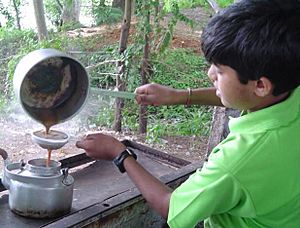
The simplest traditional method of preparing masala chai is through decoction, by actively simmering or boiling a mixture of milk and water with loose-leaf tea, sweeteners, and whole spices. Indian markets all over the world sell various brands of chai masala, (Hindi चाय मसाला [chāy masālā], "tea spice") for this purpose, though many households or tea vendors, known in India as chai wallahs, blend their own. The solid tea and spice residues are strained off from masala chai before serving.
The method may vary according to taste or local custom; for example, some households may combine all of the ingredients at the start, bring the mixture to a boil, then immediately strain and serve; others may leave the mixture simmering for a longer time, or begin by bringing the tea leaves to a boil and only add the spices toward the end (or vice versa).
A common Maharashtrian practice for preparation of one cup of chai is to first combine one half cup of water with one-half cup of milk in a pot over heat. Sugar may be added at this point or after. Ginger is then grated into the mixture followed by adding a "tea masala". Although the ingredients may vary from region to region, "tea masala" typically consists of crushed ginger, crushed cardamom, lemongrass, cloves, and cinnamon. The mixture is brought to a boil and 1 teaspoon of loose black tea is added. The chai is immediately taken off the heat, covered, and allowed to sit for about 10 minutes to allow the black tea to infuse into the chai. The chai is then strained and served.
Consumption of tea in the Indian subcontinent
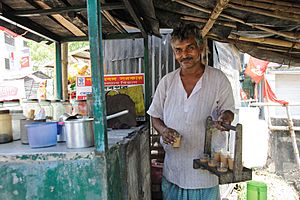
Masala chai is a very popular beverage in the Indian subcontinent (India, Pakistan, Bangladesh, Nepal and Sri Lanka). In Southern and Eastern India, however, masala chai is not the usual form; instead, tea with just milk and sugar is common.
Small vendors (called chaiwalla in Hindi/cha-ola in Bengali) are found by the side of every highway, road and alley - often the only establishments that will be open through the night. They generally also sell tobacco and snacks. Many will deliver tea to people's places of business in a chaidaan, a wooden or metal frame carrier for cups.
In the metropolitan city of Mumbai, roadside tea stalls serve smaller cups of tea at a lower budget which is referred to as 'cutting chai', the term 'cutting' referring to the halving of quantity contained in a full cup to reduce the cost of the cup of tea. Circa 2020, the cost of a 'cutting' cup of tea varies between ₹6 and ₹10 - a full cup costing ₹10 to ₹20.
Consumption beyond the Indian subcontinent
As the popularity of masala chai has spread around the world, its nature has changed in various ways beyond the somewhat redundant terminology noted above.
Masala chai is popular in East Africa and the Caribbean. It is also quite popular in the UAE, Qatar, Kuwait and Saudi Arabia; but it's locally known as Karak Tea or Chai Karak شاي كرك.
In Western cultures
Many Western supermarkets offer teabags of chai which contain an assortment of ground chai spices and require steeping in hot water.
Some American supermarkets also carry bottles of "chai spice" alongside their dried herbs and other spices. Unlike Indian spice mixtures, the American ones are generally made from powdered spices (cassia tends to be the dominant flavour) and sometimes sugar; this mixture can be added last minute to an already-brewed cup of tea as straining off the solids is not needed.
In the West, to better simulate water buffalo milk, one may try using dry or powdered milk; along with the raw or turbinado sugar normally used in India. In addition, as milk consumption in all age groups in the West has started to decrease steadily over the last 50 years, substitutes such as oat and almond milk have emerged as an alternative to water buffalo milk as well. One East-West fusion chai adds a small pinch of dark cocoa powder, indigenous to the Central Americas, to create hot chai-co-latte.
Cold chai
As an alternative to the hot tea format, several types of cold "chai" beverages have become popular in the United States. These range in complexity from a simple spiced iced tea without milk to a slush of spiced tea, ice, and milk (or nondairy creamer) mixed in a blender and topped with whipped cream. It is essentially different from the original version of a hot beverage.
Components

Depending on the establishment, chai with added espresso is now called a "java chai," "red eye chai," "turbocharger," "chai charger," "tough guy chai," and the American's preferred "dirty chai," among others. However, despite the common use in many localities to use the term "latte" as an abbreviation of "caffe latte" ("cafe latte"), the term "chai latte" does not generally imply the presence of coffee in the beverage; see the discussion of the terminology above (literally, latte is Italian for "milk").
See also
 In Spanish: Masala chai para niños
In Spanish: Masala chai para niños


